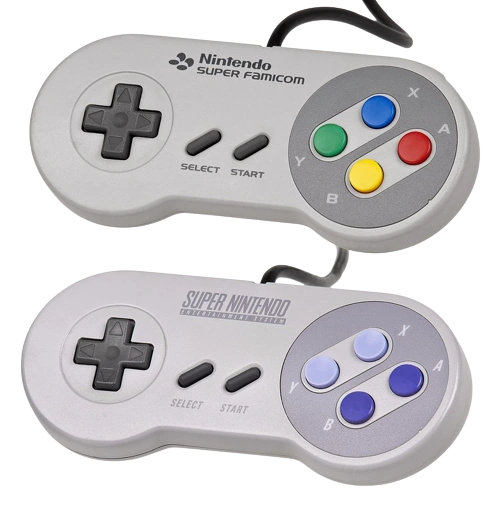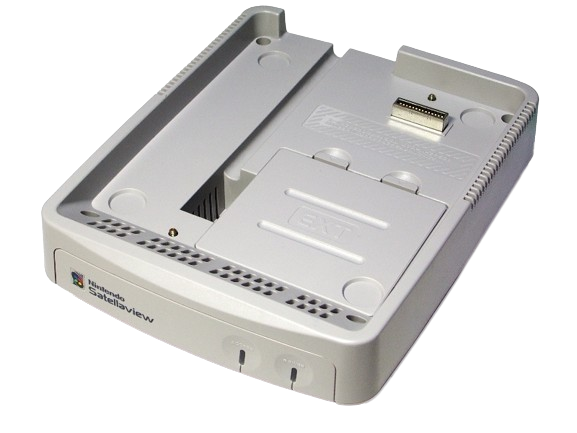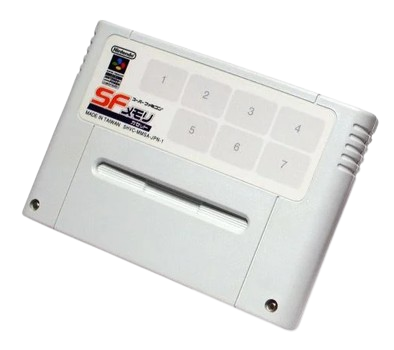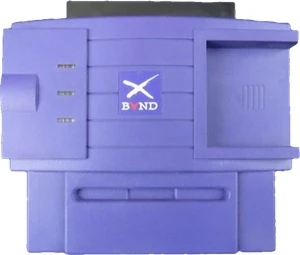The Super Nintendo Entertainment System (abbreviated to SNES, also referred to as the Super Nintendo or the Super NES), referred to as the Super Famicom in Japan, family line are a series of home consoles that were produced by Nintendo. It succeeded the Nintendo Entertainment System and was succeeded by the Nintendo 64.
The SNES has more advanced hardware and capabilities than its predecessor. In Japan and PAL regions, the Super Famicom is mainly gray with a small logo of four colors on the upper right. In North America, the SNES has a different design, now supporting purple Start and Reset buttons and losing the Super Famicom logo on the upper right with it being replaced with the English Super Nintendo logo near its left center instead. The bottom of the SNES also has a jagged design so it was easier to stack.[1] Nintendo of America Design & Brand director Lance Barr wanted the NA design of the SNES to reflect the appearance of an average home entertainment system such as a VCR hence its practical design and color scheme.[2] This change also applies to the SNES controller where its colorful buttons on the Super Famicom are now violet and purple to match the new design of the SNES.
Variants[]
| Title | Image | Release Date | Summary | |
|---|---|---|---|---|

|

| |||
Supee Famicom  Super Nintendo Entertainment System 
|
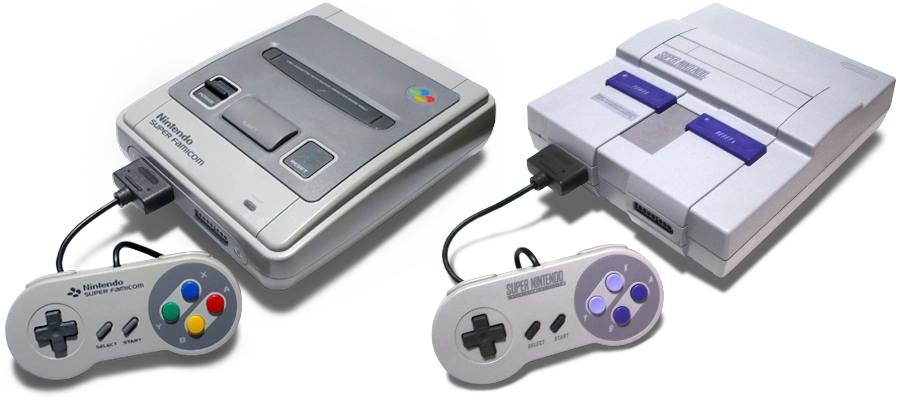
|
Aug 23, 1991 | Nov 21, 1990 | The first iterations of the consoles. The NA version sports a different design to appeal to a more mature audience. |
| Famicom Jr. New-Style Super NES 
|

|
Oct 20, 1997 | Mar 27, 1998 | A compact redesign of the previous iteration with a few removed features. |
Nintendo Classic Mini: Super Famicom  Super NES Classic Edition 
|

|
Sept 29, 2017 | Oct 5, 2017 | Hardware-upgraded versions of the original iterations. The Super Famicom design was also released in North America and PAL regions, however it sports the SNES logo instead of the Super Famicom one. Both consoles receive 21 built-in games with 16 of them being shared between NA and JP; the other five are exclusive to either of the consoles. Kirby Super Star is shared between regions whereas Kirby's Dream Course is exclusive to NA. |
Controller[]
The SNES and Super Famicom controllers have the same interface layout with different color designs. The Super Famicom has colored buttons that correspond to its four-color logo whereas the SNES takes its violet and purple colored buttons from the new stripes of purple from its North American redesign. The SNES redesign also made its controllers slightly larger and having the X and Y buttons be concave as to easily distinguish the buttons from the A and B buttons. Both variations have the Star and Select buttons at the center and a directional pad on the left with no changes to them.
The SNES controller's ABXY button layout would go on the be the basis for every mainline Nintendo console from the Nintendo DS and beyond.
Games[]
Below is a list of every Kirby game released for the SNES.
| Title | Box Art/Logo | Release Date 
|
|---|---|---|
| Kirby's Dream Course | 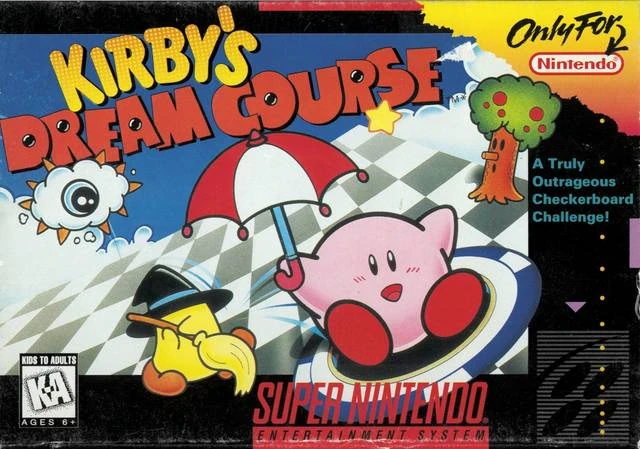
|
February 1, 1995 |
| Kirby's Avalanche | 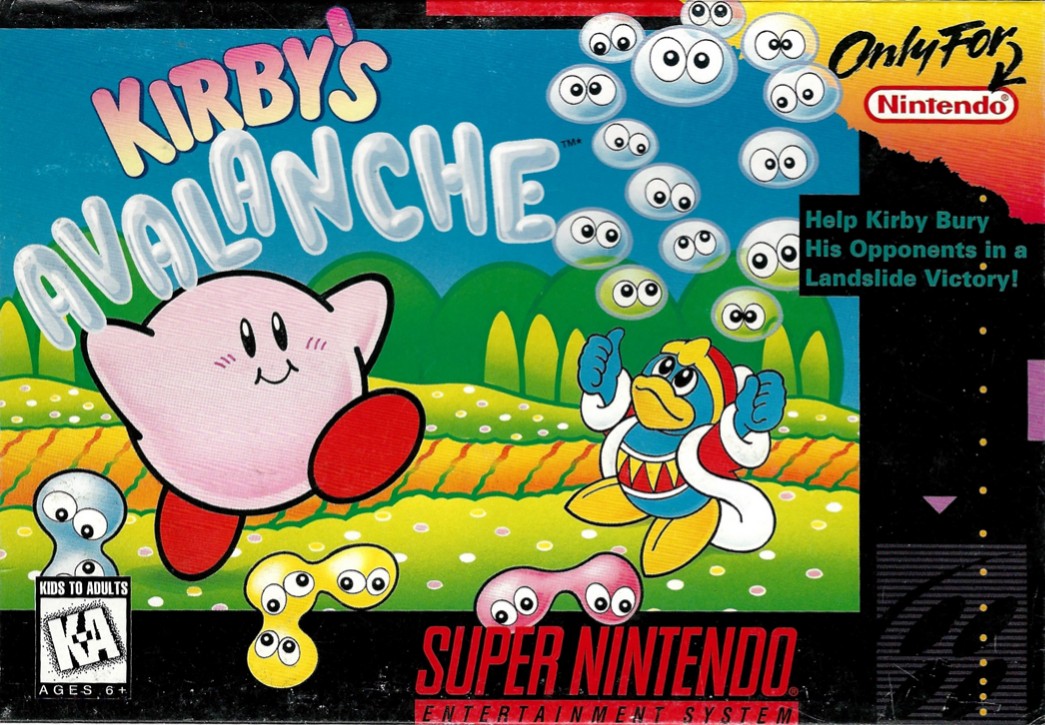
|
April 25, 1995 |
| Kirby's Toy Box | 
|
February 8, 1996 
|
| Kirby Super Star | 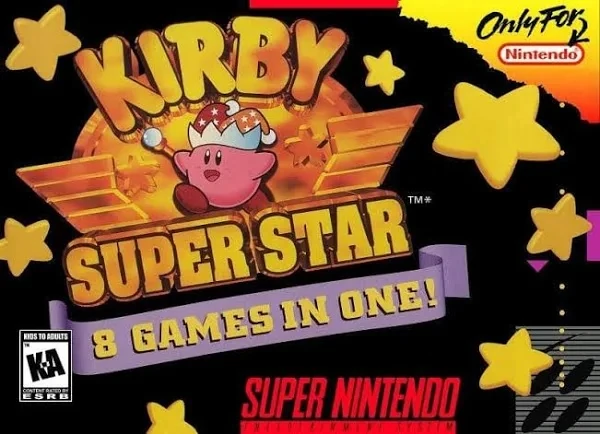
|
September 20, 1996 |
| Kirby's Dream Land 3 | 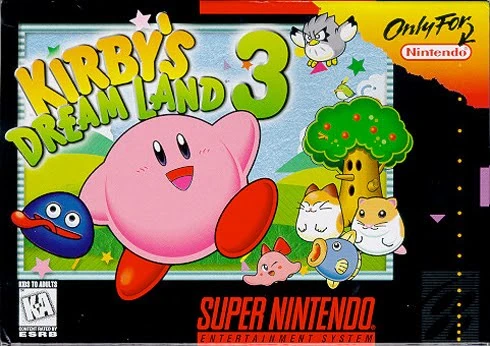
|
November 27, 1997 |
| Kirby's Star Stacker | 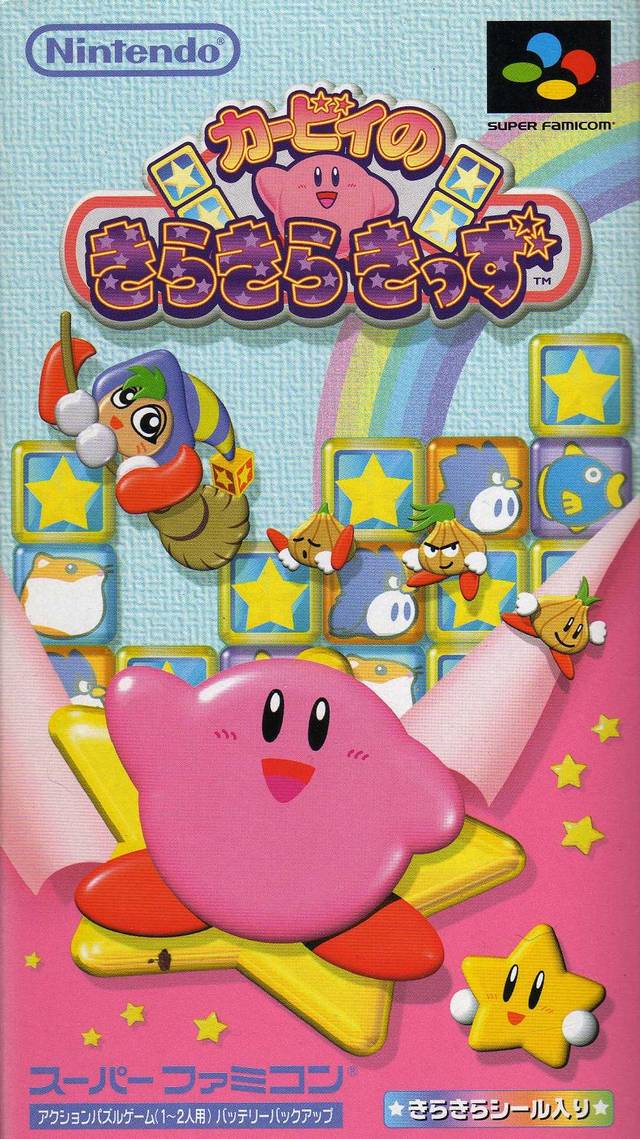
|
November 30, 1997 
|
Unreleased Kirby games[]
Related Accessories[]
Satellaview[]
The Satellaview is a Japan-only satellite modem device that allows players to download various media through Japan's online satellites such as downloading games or news. Attached to the bottom of the Super Famicom, players could play various games and remakes for the Satellaview. Kirby's Toy Box is a Satellaview-only game that could have been played using the device. An unreleased game for the Satellaview called Special Tee Shot was reworked into Kirby's Dream Course and released as a physical game instead.
Nintendo Power[]
The Nintendo Power device is an accessory that allowed users to download Super Famicom games onto a flash memory cartridge for a cheaper price than that of a regular Super Famicom cartridge. Users were to purchase an empty ROM card and bring it to a Nintendo Power kiosk to select the games they want to download onto the cartridge. This service was also available for the Game Boy. Released 1996 and discontinued 2007, below is a list of Kirby games that could have been downloaded onto the Super Famicom.
- Kirby Bowl (Released Sept 30, 1997[3])
- Kirby's Star Stacker (Released Feb 1, 1998[4])
Super Game Boy[]
The Super Game Boy peripheral is a device that allows the SNES and Super Famicom to play Game Boy and Game Boy Color cartridges. The Super Game Boy supports many special features for various Game Boy titles offering new effects and/or other features a regular Game Boy does not have.
In Japan only, a revamped and upgraded version of the Super Game Boy was released called the Super Game Boy 2. It finally allowed users to access multiplayer functions with a link port, however it does not allow the user to swap boarders if a game has a built-in boarder. Despite being released in Japan only, it can still run other regional versions of any supported games.
Kirby's Dream Land and Kirby's Pinball Land have special default palettes when played on the Super Game Boy with the former having 16,[5] and the latter having 8.[6]
Kirby's Dream Land 2, Kirby's Block Ball, and Kirby's Star Stacker all get new color palettes and a special game boarder; the first and last aforementioned games get new sound effects. Kirby's Star Stacker on the Super Game Boy shares its sounds commands with Kirby's Dream Land 2, some of them being unused in either or both games.[7]
XBAND[]
The XBAND modem was an accessory modem that allowed players to compete against other players via an online network that hosts a variety of services such as matchmaking and downloading the service’s daily edition of newspapers that displays high scores; high scores for Kirby’s Avalanche were also recorded by the XBAND.[8] Most games connected matchmaking via dial up, thus one would have to use a phone and hope another player was also using the phone and playing the same game. By manipulating the game's memory, it essentially "unlocks" features that were not present in the original code thus allowing games such as Kirby's Avalanche to support an online matchmaking option, making Kirby's Avalanche the first Kirby game to utilize any online function. Only released in North America in 1994, it was short-lived as it received very poor reception, however it was one of the first ever online competitive gaming networks.
Every online win in Kirby's Avalanche using the XBAND would give the winner one tally next to their profile as a trophy of their cumulative wins in any game in general.[9]
Trivia[]

- Various physical packaging for the New-Style SNES promotes a singular SNES game on its box art. Kirby Super Star is one of these games where it even uses its North American name for PAL regions instead of Kirby's Fun Pak.
- Kirby's History in Kirby's Dream Collection Special Edition uses art of the SNES in the NA version of the game whereas it uses a Super Famicom in the JP version. This is also true for the Nintendo Entertainment System and the Famicom.
Gallery[]
References[]
- ↑ Here's The Reason Why The North American Super NES Looks So Different | Nintendo Life
- ↑ Why The North American SNES Looked So Different From The Rest Of The World's Consoles (svg.com)
- ↑ Super Famicom Nintendo Power Game List (Japan) | NinDB
- ↑ Super Famicom | Nintendo.co.jp
- ↑ Super Game Boy ~ games with default palettes - Kirby Dream Land (2C) - YouTube
- ↑ Super Game Boy ~ Games with default palettes - Kirby's Pinball (1C) - YouTube
- ↑ Kirby's Star Stacker - The Cutting Room Floor (tcrf.net)
- ↑ Reddit post
- ↑ retrojunk.com

